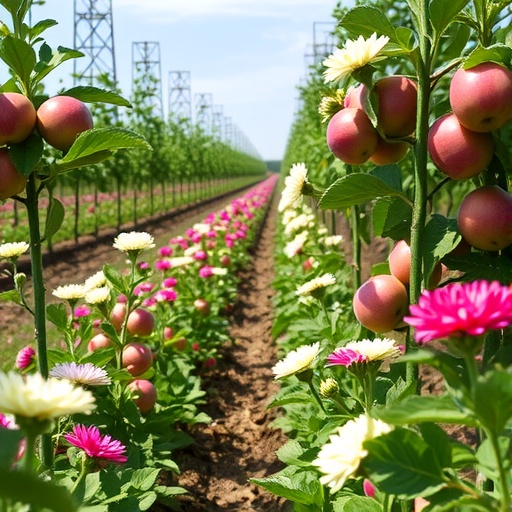In an era where sustainable agriculture is not just an ideal but an imperative, recent research has illuminated a cost-effective and ecologically beneficial method to enhance apple orchard productivity: the strategic planting of perennial wildflower strips. This innovative approach promises to reduce farmers’ reliance on chemical pesticides while simultaneously fostering biodiversity and improving the overall health of orchard ecosystems. The financial implications are equally significant, with potential savings of up to £3,000 per hectare annually, making it both an economically and environmentally sound practice.
The core mechanism behind this natural pest control lies in the attraction and sustained presence of predatory insects such as ladybirds, hoverflies, and lacewings. These beneficial insects prey on common apple orchard pests, particularly aphids, which are notorious for damaging crops by feeding on sap and transmitting diseases. By offering a habitat rich in nectar and pollen, flower strips serve as a reservoir that supports these natural pest antagonists, thereby reducing the frequency and dosage of chemical insecticides required—a win for farmers and the environment alike.
A pivotal study conducted by a multidisciplinary team including experts from the University of Reading, NIAB East Malling, Cranfield University, and Syngenta sheds light on the effectiveness of this method. Published in the Journal of Agricultural Economics, the research integrated extensive field trials over two consecutive growing seasons across various UK orchards. Some orchards incorporated strategically located flower strips while others did not, allowing for a comparative analysis of pest levels, apple damage, and economic returns.
Intriguingly, the positioning of flower strips emerged as a critical determinant of their efficacy. Flower strips planted along the edges of orchards, particularly when they replaced grass margins or, in some cases, apple trees themselves, significantly enhanced pest suppression and financial return. This spatial optimization arguably outperformed other variables such as government subsidies for planting or the longevity of the flower strips, underscoring the importance of precise ecological integration over blanket implementation.
The study quantified the impact of such interventions by assessing the reduction in damage caused by rosy apple aphids—a pervasive and economically damaging pest. During years characterized by high pest pressure, the introduction of flower strips corresponded with a reduction in aphid-related damage by up to 32%. Such a decline directly translates to improved fruit yield and quality, factors that strongly influence market profitability.
Beyond pest control, the ecological benefits of wildflower strips extend into enhanced pollination and carbon sequestration. Pollinating insects supported by these flower-rich habitats improve fruit set and orchard biodiversity, creating a more resilient agroecosystem. Moreover, these strips contribute to carbon capture, playing a niche role in mitigating climate change impacts within agricultural landscapes, an area increasingly recognized as critical in climate-smart farming strategies.
Economic modeling performed by the researchers revealed that even in years with low pest incidence, flower strips’ benefits justified their establishment costs, particularly when sited optimally at orchard margins. This finding challenges the assumption that such ecological interventions only pay off under high pest pressure, suggesting a reliable, year-round benefit to the incorporation of biodiversity-friendly practices.
The implications of this research resonate far beyond the apple industry. Flower strips could serve as a blueprint for integrated pest management (IPM) strategies in diverse cropping systems, promoting a paradigm shift towards ecological intensification. This concept is crucial as farmers worldwide face mounting pressures from pest resistance, regulatory constraints on agrochemicals, and consumer demand for sustainably-produced food.
Lead author Dr. Charlotte Howard articulated the broader vision: “Our findings underscore the value of letting nature take part in crop protection. Through ecological engineering such as wildflower strips, farmers can harmonize productivity with conservation, achieving sustainable farming systems that are beneficial economically, environmentally, and socially.”
To aid the practical adoption of this knowledge, the research consortium has developed straightforward guides for farmers, delineating best practices for flower strip design, species selection, and placement. These resources seek to bridge the gap between scientific insight and on-the-ground application, empowering growers to implement these nature-based solutions effectively.
The collaboration involved in this research exemplifies multidisciplinary integration, combining expertise in entomology, agronomy, ecology, and economics. It also featured partnerships with industry stakeholders, including Avalon Produce and Worldwide Fruit, ensuring that findings are relevant, tailored, and readily translatable into commercial orchard management.
Given the urgent need to reduce agricultural environmental footprints, studies like this contribute vital evidence supporting systemic change. As insect populations face global declines and chemical usage raises environmental and health concerns, solutions that work with natural ecological processes rather than against them are gaining momentum and recognition.
In summary, planting perennial wildflower strips is emerging as a scientifically validated, economically viable, and ecologically advantageous method for pest control in apple orchards. It harnesses the power of natural predation and pollination services, bolsters biodiversity, and offers tangible financial returns. This strategy embodies the future of sustainable horticulture, where productivity and environmental stewardship go hand-in-hand.
Subject of Research: Sustainable pest control in apple orchards via perennial wildflower strips.
Article Title: Perennial Flower Strips Can Be a Cost-Effective Tool for Pest Suppression in Orchards.
News Publication Date: 26-Apr-2025.
Web References:
- Journal article DOI: 10.1111/1477-9552.12631
- University of Reading News: Creepy crawlies protect apples
- NIAB Fact Sheets: Wildflower research in apples factsheet
References: Journal of Agricultural Economics.
Keywords: Farming, Agriculture, Sustainable Pest Management, Biodiversity, Pollination, Carbon Sequestration, Integrated Pest Management, Ecological Intensification.




